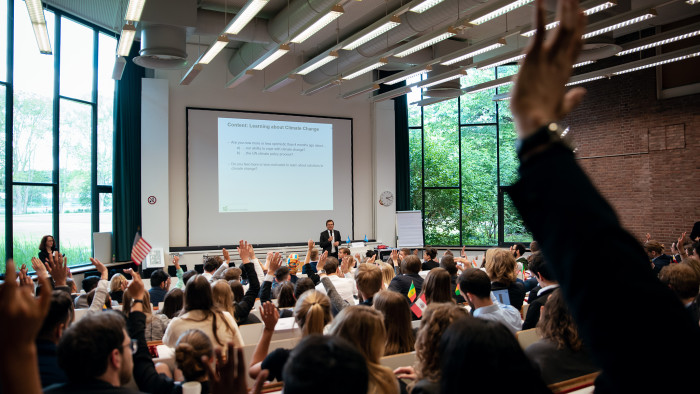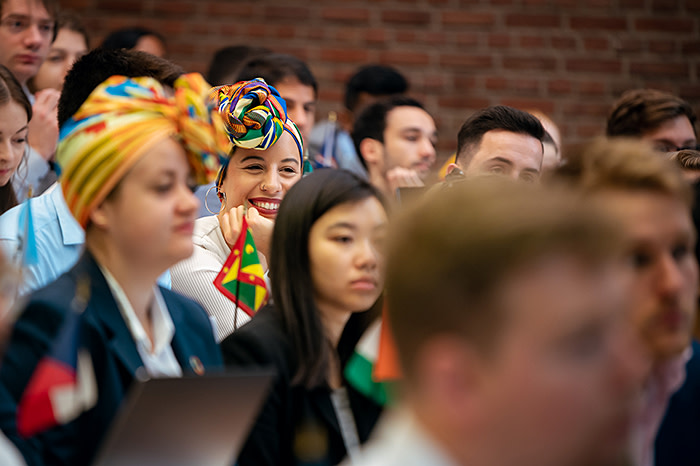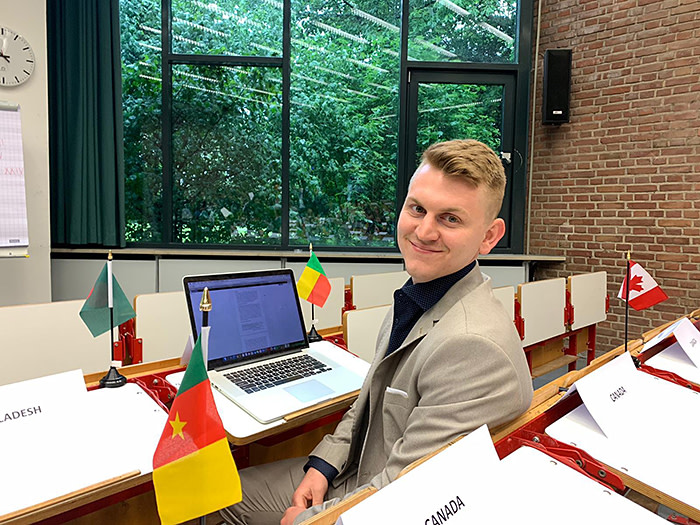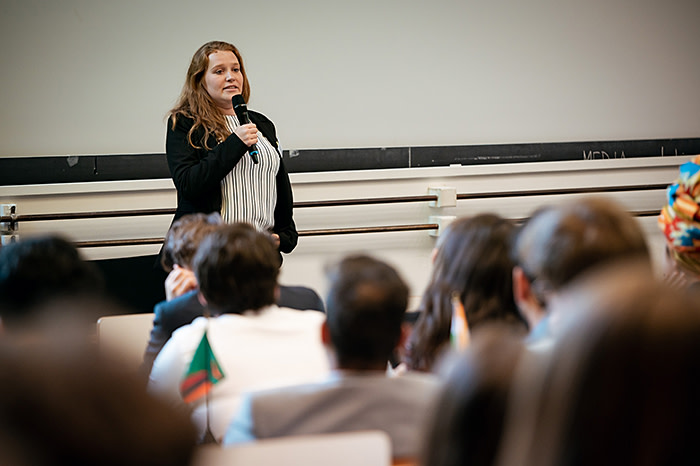Climate change: how business school students play their part

Simply sign up to the Climate change myFT Digest -- delivered directly to your inbox.
With less than an hour to go in a two-day series of climate change negotiations, Adele Grundmann found herself in a deadlock. Her hopes of an agreement for her market mechanism were about to be dashed.
The US and Chinese delegations had pushed to include fossil fuels in the sustainable development mechanism. This was non-negotiable for Grundmann, who was representing Canada, as these fuels would then qualify for emissions-trading schemes. Risking everything as the countdown began, she threatened to not sign the agreement.
It may not have been the real UN Conference of Parties, but this live simulation at the University of Cologne was nonetheless emotionally gripping. The two-day conference took place in May as the final part of the Model UNFCCC (United Nations Framework Convention on Climate Change) course run by Cems, the international alliance of business schools. Each student represented a country, non-governmental organisation (NGO) or industry group, and worked together to reach a consensus on how to limit carbon emissions to well below 2C.

“I didn’t think it would even come this far as we had already discussed it,” says Grundmann, a student at the University of St Gallen in Switzerland. “I shouldn’t have been the only one blocking it. The entire European Union should have been on my side.” Alone and pushing against the consensus, she started to have doubts. “It got very heated, voices were raised and people stormed out of the room — it was a very intense experience,” she says. “No one wants to go out after 48 hours with no agreement, and it would have ruined the party afterwards.” Eventually the other delegates accepted Grundmann’s red line and the agreement went ahead without fossil fuels.
Now in its 11th year, the UNFCCC programme is designed to prepare masters in management students for the challenge of climate change, teaching them the latest science, policy and the role of business in tackling global warming. “Students come in with a frustration that politics is not ambitious enough when it comes to climate change,” says Johanna Bocklet, who teaches the programme at the University of Cologne. “But when they step into the role of government groups and NGOs they come to understand how complex the negotiations are. We teach them a little realism.”
The UN-backed course is organised by Cems and taught in parallel to 150 students at nine participating European schools, who gather at the end to take part in the conference.
For Rafael Sardá, a scientist and co-founder of the programme, who also teaches it at Esade in Barcelona, the transformation of the students’ understanding in a few weeks is impressive. “The first thing I do in class is to see what the students know about climate change,” he says. “At the beginning they don’t know anything. You see how they advance, how they absorb all the concepts and apply them to the role they get in the conference. It’s amazing.”
Sardá says there has long been a communication gap between the scientific community and the wider world. As the current rate of global warming is around 0.3C per decade, he fears that without urgent and significant action it will reach 1.5C between 2030 and 2035. He hopes that if more students learn the facts, they will be better prepared as they go into business.
“Knowing the evidence on climate change and the current trends on how sustainability should be managed in business is fundamental,” he says. “We are facing a world catastrophe in two decades — things are getting dramatically accelerated.”
The course has three modules: first, an introduction to climate change science and policy, including how companies can implement sustainable practices; students are then each assigned a country or group to represent and they write a background paper; finally, there is the conference.

This year, for the first time, Bocklet let students submit preferences for which country they wanted to represent. “Lots of them wanted to play the bad guys. It surprised me, but it makes sense: if you want to understand why there is such slow progress, you need to understand their reasoning.” The students take it very seriously, she says, keeping to their roles. “It’s very difficult for them to get out of it, even during dinner and drinks. Sometimes I feel a little bad for the bad guys.”
Margot Kwee was studying at Bocconi University in Milan as an exchange student and had already taken sustainability modules, but she says the UNFCCC course was different: “It really gave me a more complete view of what has to be done, how it has to be done.”
To challenge herself she asked to represent South Korea and successfully advocated the use of technology in combating climate change, despite some resistance when financing was discussed. “They were saying one thing, but when it came to putting money on the table it was much more difficult,” she says. Progress initially was slow in the official meetings, but students started to negotiate and form alliances during the breaks, which she says made it easier to find common ground.
Representing Benin in west Africa, University of Cologne student Benjamin van der Horst quickly realised how much smaller countries rely on the bigger players during the negotiations. “My strategy was to be as belligerent as possible because everyone would overlook Benin. I got a few of my proposals ratified, but it was a sobering experience, especially being an American. I can’t imagine what it’s like being one of those smaller countries.

“There was a lot of drama. When my proposals were ignored I found myself getting really emotionally invested — not yelling, but [there were] raised tempers. Pretty much everyone involved got heated.”
On completing the course, the students are asked whether they think global climate change agreements will solve the problem. Although the majority say no, Bocklet says participants leave with a clearer understanding of what they can do as individuals to effect change.
“There is some change in perspective,” says Bocklet. Several former students have taken internships at environmental companies. “It’s a start of a rethinking of their career,” she says. “Lots of them afterwards want to do something meaningful. Even if they go into finance or consulting, it’s good to keep that in the back of their mind.”
“It made me even more excited about the sustainability field,” says Kwee. “Even though it’s frustrating and takes a while, you do see it has impact.” She now appreciates the value of organisations collaborating to drive progress. “I really saw that this is what pushes you forward,” she adds.
Van der Horst would now think twice about working for certain companies and believes the business world has a responsibility to act on climate change. “We’re the next generation of business leaders and we are the ones who will have to come up with solutions to solve it,” he says.
Greg Whitwell, chair of Cems and dean of the University of Sydney Business School, says the UNFCCC programme is at the heart of Cems’ attempts to prepare responsible leaders for a more sustainable world. “We are now in a period of profound change. Business will be increasingly subject to megatrends, and climate change is one of them,” Prof Whitwell says. Students learn how to negotiate with diverse stakeholders, to understand different perspectives and to question the things they take for granted, he says. “This is really extending the boundaries of business education, the need to take a multidisciplinary approach.”
Nine of 32 Cems schools currently offer the UNFCCC course, and Prof Whitwell hopes to replicate the European model in Asia-Pacific schools in the near future.
“For me the goal is to light a fire, to start students thinking about sustainability and climate change in their future career,” says Bocklet. “Not everyone needs to go and join an NGO, but every company should join the fight.”
Comments